Chemical Characterization of Honey and Its Effect (Alone as well as with Synthesized Silver Nanoparticles) on Microbial Pathogens’ and Human Cancer Cell Lines’ Growth
Abstract
1. Introduction
2. Materials and Methods
2.1. Chemicals and Reagents
2.2. Physicochemical Analysis of Honey
Sugar Analysis Using a High-Performance Liquid Chromatography-Refractive Index Detector (HPLC-RID)
2.3. Synthesis of Nanoparticles
2.3.1. Green Synthesis of AgNPs
2.3.2. Characterisation
2.4. Well-Diffusion Method for Antibacterial Susceptibility Assay
2.5. Growth Kinetic Assay
2.6. Anticancer Properties of Honey
2.6.1. Cell Culture
2.6.2. Cell Viability Assay
3. Results
3.1. Physiochemical Properties of Honey
3.2. UV—Vis Spectra of Forest Honey
3.3. Scanning Electron Microscopy (SEM)
3.4. Antibacterial Efficacy of the Synthesised Compounds
3.5. Effect on Bacterial Growth
3.6. Anticancer Effect on Different Cell Lines
4. Discussion
5. Conclusions
Author Contributions
Funding
Institutional Review Board Statement
Informed Consent Statement
Data Availability Statement
Acknowledgments
Conflicts of Interest
References
- El Sohaimy, S.A.; Masry, S.; Shehata, M. Physicochemical characteristics of honey from different origins. Ann. Agric. Sci. 2015, 60, 279–287. [Google Scholar] [CrossRef]
- Dos Santos Scholz, M.B.; Júnior, A.Q.; Delamuta, B.H.; Nakamura, J.M.; Baudraz, M.C.; Reis, M.O.; Kato, T.; Pedrão, M.R.; Dias, L.F.; Dos Santos, D.T.R. Indication of the geographical origin of honey using its physicochemical characteristics and multivariate analysis. J. Food Sci. Technol. 2020, 57, 1896–1903. [Google Scholar] [CrossRef] [PubMed]
- Zheng, X.; Zhao, Y.; Naumovski, N.; Zhao, W.; Yang, G.; Xue, X.; Wu, L.; Granato, D.; Peng, W.; Wang, K. Systems Biology Approaches for Understanding Metabolic Differences Using ‘Multi-Omics’ Profiling of Metabolites in Mice Fed with Honey and Mixed Sugars. Nutrients 2022, 14, 3445. [Google Scholar] [CrossRef] [PubMed]
- Cortés, M.E.; Vigil, P.; Montenegro, G. The medicinal value of honey: A review on its benefits to human health, with a special focus on its effects on glycemic regulation. Cienc. E Investig. Agrar. 2011, 38, 303–317. [Google Scholar] [CrossRef]
- Samarghandian, S.; Farkhondeh, T.; Samini, F. Honey and Health: A Review of Recent Clinical Research. Pharmacogn. Res. 2017, 9, 121–127. [Google Scholar] [CrossRef]
- Rana, S.; Mishra, M.; Yadav, D.; Subramani, S.K.; Katare, C.; Prasad, G. Medicinal uses of honey: A review on its benefits to human health. Prog. Nutr. 2018, 20, 5–14. [Google Scholar] [CrossRef]
- Ajibola, A. Novel Insights into the Health Importance of Natural Honey. Malays. J. Med Sci. 2015, 22, 7–22. [Google Scholar]
- Eteraf-Oskouei, T.; Najafi, M. Traditional and modern uses of natural honey in human diseases: A review. Iran J. Basic Med. Sci. 2013, 16, 731–742. [Google Scholar] [PubMed]
- Muhamad, R.; Draman, N.; Aziz, A.A.; Abdullah, S.; Jaeb, M.Z.M. The effect of Tualang honey on the quality of life of patients with chronic obstructive pulmonary disease: A randomized controlled trial. J. Taibah Univ. Med Sci. 2017, 13, 42–50. [Google Scholar] [CrossRef] [PubMed]
- Ramli, N.Z.; Chin, K.Y.; Zarkasi, K.A.; Ahmad, F. A Review on the Protective Effects of Honey against Metabolic Syndrome. Nutrients 2018, 10, 1009. [Google Scholar] [CrossRef]
- Hossain, K.S.; Hossain, M.G.; Moni, A.; Rahman, M.M.; Rahman, U.H.; Alam, M.; Kundu, S.; Rahman, M.M.; Hannan, M.A.; Uddin, M.J. Prospects of honey in fighting against COVID-19: Pharmacological insights and therapeutic promises. Heliyon 2020, 6, e05798. [Google Scholar] [CrossRef] [PubMed]
- Terrab, A.; Recamales, A.F.; Hernanz, D.; Heredia, F.J. Characterisation of Spanish thyme honeys by their physicochemical characteristics and mineral contents. Food Chem. 2004, 88, 537–542. [Google Scholar] [CrossRef]
- White, J.; Doner, L.W. Honey composition and properties. Beekeep. United States Agric. Handb. 1980, 335, 82–91. [Google Scholar]
- Ajlouni, S.; Sujirapinyokul, P. Hydroxymethylfurfuraldehyde and amylase contents in Australian honey. Food Chem. 2010, 119, 1000–1005. [Google Scholar] [CrossRef]
- Belay, A.; Haki, G.D.; Birringer, M.; Borck, H.; Lee, Y.-C.; Kim, K.-T.; Baye, K.; Melaku, S. Enzyme activity, amino acid profiles and hydroxymethylfurfural content in Ethiopian monofloral honey. J. Food Sci. Technol. 2017, 54, 2769–2778. [Google Scholar] [CrossRef]
- Kędzierska-Matysek, M.; Teter, A.; Florek, M.; Matwijczuk, A.; Niemczynowicz, A.; Matwijczuk, A.; Czernel, G.; Skałecki, P.; Gładyszewska, B. Use of physicochemical, FTIR and chemometric analysis for quality assessment of selected monofloral honeys. J. Apic. Res. 2021, 1900637. [Google Scholar] [CrossRef]
- Ouchemoukh, S.; Louaileche, H.; Schweitzer, P. Physicochemical characteristics and pollen spectrum of some Algerian honeys. Food Control. 2007, 18, 52–58. [Google Scholar] [CrossRef]
- Belay, A.; Haki, G.D.; Birringer, M.; Borck, H.; Lee, Y.-C.; Cho, C.-W.; Kim, K.-T.; Bayissa, B.; Baye, K.; Melaku, S. Sugar profile and physicochemical properties of Ethiopian monofloral honey. Int. J. Food Prop. 2017, 20, 2855–2866. [Google Scholar] [CrossRef]
- De Sousa, J.M.B.; de Souza, E.L.; Marques, G.; de Toledo Benassi, M.; Gullón, B.; Pintado, M.M.; Magnani, M. Sugar profile, physicochemical and sensory aspects of monofloral honeys produced by different stingless bee species in Brazilian semi-arid region. LWT—Food Sci. Technol. 2016, 65, 645–651. [Google Scholar] [CrossRef]
- López-Esparza, J.; Espinosa-Cristóbal, L.F.; Donohue-Cornejo, A.; Reyes-López, S.Y. Antimicrobial activity of silver nanoparticles in polycaprolactone nanofibers against gram-positive and gram-negative bacteria. Ind. Eng. Chem. Res. 2016, 55, 12532–12538. [Google Scholar] [CrossRef]
- Pasupuleti, V.R. Nanoscience and nanotechnology advances in food industry. In Future Foods; Elsevier: Amsterdam, The Netherlands, 2022; pp. 721–732. [Google Scholar]
- Thiruvengadam, M.; Rajakumar, G.; Chung, I.-M. Nanotechnology: Current uses and future applications in the food industry. 3 Biotech 2018, 8, 74. [Google Scholar] [CrossRef] [PubMed]
- Balasooriya, E.R.; Jayasinghe, C.D.; Jayawardena, U.A.; Ruwanthika, R.W.D.; de Silva, R.M.; Udagama, P.V. Honey Mediated Green Synthesis of Nanoparticles: New Era of Safe Nanotechnology. J. Nanomater. 2017, 2017, 5919836. [Google Scholar] [CrossRef]
- Bayda, S.; Adeel, M.; Tuccinardi, T.; Cordani, M.; Rizzolio, F. The History of Nanoscience and Nanotechnology: From Chemical-Physical Applications to Nanomedicine. Molecules 2019, 25, 112. [Google Scholar] [CrossRef] [PubMed]
- Patra, J.K.; Das, G.; Fraceto, L.F.; Campos, E.V.R.; del Pilar Rodriguez-Torres, M.; Acosta-Torres, L.S.; Diaz-Torres, L.A.; Grillo, R.; Swamy, M.K.; Sharma, S.; et al. Nano based drug delivery systems: Recent developments and future prospects. J. Nanobiotechnol. 2018, 16, 71. [Google Scholar] [CrossRef]
- Hemath Naveen, K.; Kumar, G.; Karthik, L.; Bhaskara Rao, K. Extracellular biosynthesis of silver nanoparticles using the filamentous fungus Penicillium sp. Arch. Appl. Sci. Res. 2010, 2, 161–167. [Google Scholar]
- Patil, S.; Chandrasekaran, R. Biogenic nanoparticles: A comprehensive perspective in synthesis, characterization, application and its challenges. J. Genet. Eng. Biotechnol. 2020, 18, 67. [Google Scholar] [CrossRef] [PubMed]
- Hanžić, N.; Jurkin, T.; Maksimović, A.; Gotić, M. The synthesis of gold nanoparticles by a citrate-radiolytical method. Radiat. Phys. Chem. 2015, 106, 77–82. [Google Scholar] [CrossRef]
- Iravani, S. Green synthesis of metal nanoparticles using plants. Green Chem. 2011, 13, 2638–2650. [Google Scholar] [CrossRef]
- Ghramh, H.A.; Ibrahim, E.H.; Kilany, M. Study of anticancer, antimicrobial, immunomodulatory, and silver nanoparticles production by Sidr honey from three different sources. Food Sci. Nutr. 2020, 8, 445–455. [Google Scholar] [CrossRef]
- Molan, P.C. The antibacterial activity of honey: 1. The nature of the antibacterial activity. Bee World 1992, 73, 5–28. [Google Scholar] [CrossRef]
- Cornara, L.; Biagi, M.; Xiao, J.; Burlando, B. Therapeutic properties of bioactive compounds from different honeybee products. Front. Pharmacol. 2017, 8, 412. [Google Scholar] [CrossRef] [PubMed]
- Jull, A.B.; Cullum, N.; Dumville, J.C.; Westby, M.J.; Deshpande, S.; Walker, N. Honey as a topical treatment for wounds. Cochrane Database Syst. Rev. 2015, 2015, CD005083. [Google Scholar] [CrossRef] [PubMed]
- Kudva, A.K.; Rao, S.; Rao, P.; Pais, M.L.; Adnan, M.; Pai, K.S.R.; Baliga, M.S. Evidence for anticancer properties of honey with emphasis on mechanistic overview. Funct. Foods Cancer Prev. Ther. 2020, 00007-7. [Google Scholar] [CrossRef]
- Kaya, B.; Yıldırım, A. Determination of the antioxidant, antimicrobial and anticancer properties of the honey phenolic extract of five different regions of Bingöl province. J. Food Sci. Technol. 2021, 58, 2420–2430. [Google Scholar] [CrossRef]
- Alharbi, N.S.; Alsubhi, N.S.; Felimban, A.I. Green synthesis of silver nanoparticles using medicinal plants: Characterization and application. J. Radiat. Res. Appl. Sci. 2022, 15, 109–124. [Google Scholar] [CrossRef]
- Beyene, H.D.; Werkneh, A.A.; Bezabh, H.K.; Ambaye, T.G. Synthesis paradigm and applications of silver nanoparticles (AgNPs), a review. Sustain. Mater. Technol. 2017, 13, 18–23. [Google Scholar] [CrossRef]
- Kowalczyk, P.; Szymczak, M.; Maciejewska, M.; Laskowski, Ł.; Laskowska, M.; Ostaszewski, R.; Skiba, G.; Franiak-Pietryga, I. All that glitters is not silver—A new look at microbiological and medical applications of silver nanoparticles. Int. J. Mol. Sci. 2021, 22, 854. [Google Scholar] [CrossRef] [PubMed]
- Hosny, A.; Kashef, M.; Rasmy, S.; Aboul-Magd, D.; El-Bazza, Z. Antimicrobial activity of silver nanoparticles synthesized using honey and gamma radiation against silver-resistant bacteria from wounds and burns. Adv. Nat. Sci. Nanosci. Nanotechnol. 2017, 8, 045009. [Google Scholar] [CrossRef]
- Das, P.; Ghosal, K.; Jana, N.K.; Mukherjee, A.; Basak, P. Green synthesis and characterization of silver nanoparticles using belladonna mother tincture and its efficacy as a potential antibacterial and anti-inflammatory agent. Mater. Chem. Phys. 2019, 228, 310–317. [Google Scholar] [CrossRef]
- Amiri, M.R.; Alavi, M.; Taran, M.; Kahrizi, D. Antibacterial, antifungal, antiviral, and photocatalytic activities of TiO2 nanoparticles, nanocomposites, and bio-nanocomposites: Recent advances and challenges. J. Public Health Res. 2022, 11, 22799036221104151. [Google Scholar] [CrossRef]
- Czernel, G.; Bloch, D.; Matwijczuk, A.; Cieśla, J.; Kędzierska-Matysek, M.; Florek, M.; Gagoś, M. Biodirected Synthesis of Silver Nanoparticles Using Aqueous Honey Solutions and Evaluation of Their Antifungal Activity against Pathogenic Candida Spp. Int. J. Mol. Sci. 2021, 22, 7715. [Google Scholar] [CrossRef]
- El-Bisi, M.; El-Rafie, H.; El-Rafie, M.; Hebeish, A. Honey bee for eco-friendly green synthesis of silver nanoparticles and application to cotton textile. Egypt. J. Chem. 2013, 56, 187–198. [Google Scholar]
- Ghramh, H.A.; Ibrahim, E.H.; Ahmad, Z. Antimicrobial, immunomodulatory and cytotoxic activities of green synthesized nanoparticles from Acacia honey and Calotropis procera. Saudi J. Biol. Sci. 2021, 28, 3367–3373. [Google Scholar] [CrossRef] [PubMed]
- Marsudi, M.A.; Sari, F.F.; Wicaksono, P.M.; Asmoro, A.; Basuki, A.; Wibowo, A. Optimization of Green Synthesis Approach of Silver Nanoparticles Using Indonesian Wild Honey. In Key Engineering Materials; Trans Tech Publications Ltd.: Stafa-Zurich, Switzerland, 2021; pp. 111–115. [Google Scholar]
- Bogdanov, S.; Martin, P.; Lullmann, C. Harmonised methods of the international honey commission. Swiss Bee Res. Cent. FAM Liebefeld 2002, 5, 1–62. [Google Scholar]
- Bogdanov, S. Nature and origin of the antibacterial substances in honey. LWT-Food Sci. Technol. 1997, 30, 748–753. [Google Scholar] [CrossRef]
- Khan, K.A.; Ghramh, H.A. Nutritional efficacy of different diets supplemented with microalga Arthrospira platensis (spirulina) in honey bees (Apis mellifera). J. King Saud Univ.—Sci. 2022, 34, 101819. [Google Scholar] [CrossRef]
- Arora, S.; Saquib, S.A.; Algarni, Y.A.; Kader, M.A.; Ahmad, I.; Alshahrani, M.Y.; Saluja, P.; Baba, S.M.; Abdulla, A.M.; Bavabeedu, S.S. Synergistic effect of plant extracts on endodontic pathogens isolated from teeth with root canal treatment failure: An in vitro study. Antibiotics 2021, 10, 552. [Google Scholar] [CrossRef]
- Beretta, G.; Moretti, R.M.; Nasti, R.; Cincinelli, R.; Dallavalle, S.; Marelli, M.M. Apoptosis-mediated anticancer activity in prostate cancer cells of a chestnut honey (Castanea sativa L.) quinoline–pyrrolidine gamma-lactam alkaloid. Amino Acids 2021, 53, 869–880. [Google Scholar] [CrossRef]
- Alam, M.M.; Nazreen, S.; Almalki, A.S.; Elhenawy, A.A.; Alsenani, N.I.; Elbehairi, S.E.I.; Malebari, A.M.; Alfaifi, M.Y.; Alsharif, M.A.; Alfaifi, S.Y. Naproxen Based 1,3,4-Oxadiazole Derivatives as EGFR Inhibitors: Design, Synthesis, Anticancer, and Computational Studies. Pharmaceuticals 2021, 14, 870. [Google Scholar] [CrossRef] [PubMed]
- Izwan, Z.M. Study on Antioxidant Capacity, Antibacterial Activity, Phenolic Profile and microbial Screening Of Selected Malaysian and Turkish Honey/Mohd Izwan Zainol; University of Malaya: Kuala Lumpur, Malaysia, 2016. [Google Scholar]
- Alvarez-Suarez, J.M.; Gasparrini, M.; Forbes-Hernández, T.Y.; Mazzoni, L.; Giampieri, F. The composition and biological activity of honey: A focus on Manuka honey. Foods 2014, 3, 420–432. [Google Scholar] [CrossRef]
- Ismail, M.; Abdallah, E.M.; Elsharkawy, E.R. Physico-chemical properties, antioxidant, and antimicrobial activity of five varieties of honey from Saudi Arabia. Asia Pac. J. Mol. Biol. Biotechnol 2021, 2021, 27–34. [Google Scholar] [CrossRef]
- Van Viet, P.; Sang, T.T.; Bich, N.H.N.; Thi, C.M. An improved green synthesis method and Escherichia coli antibacterial activity of silver nanoparticles. J. Photochem. Photobiol. B Biol. 2018, 182, 108–114. [Google Scholar] [CrossRef] [PubMed]
- Kajani, A.A.; Bordbar, A.-K.; Esfahani, S.H.Z.; Razmjou, A. Gold nanoparticles as potent anticancer agent: Green synthesis, characterization, and in vitro study. RSC Adv. 2016, 6, 63973–63983. [Google Scholar] [CrossRef]
- Kumar, B.; Smita, K.; Cumbal, L.; Debut, A. Green synthesis of silver nanoparticles using Andean blackberry fruit extract. Saudi J. Biol. Sci. 2017, 24, 45–50. [Google Scholar] [CrossRef]
- Sadeghi, B.; Gholamhoseinpoor, F. A study on the stability and green synthesis of silver nanoparticles using Ziziphora tenuior (Zt) extract at room temperature. Spectrochim. Acta Part A Mol. Biomol. Spectrosc. 2015, 134, 310–315. [Google Scholar] [CrossRef]
- Almalki, A.S.; Nazreen, S.; Malebari, A.M.; Ali, N.M.; Elhenawy, A.A.; Alghamdi, A.A.; Ahmad, A.; Alfaifi, S.Y.; Alsharif, M.A.; Alam, M.M. Synthesis and biological evaluation of 1,2,3-triazole tethered thymol-1,3,4-oxadiazole derivatives as anticancer and antimicrobial agents. Pharmaceuticals 2021, 14, 866. [Google Scholar] [CrossRef]
- Loza, K.; Diendorf, J.; Sengstock, C.; Ruiz-Gonzalez, L.; Gonzalez-Calbet, J.; Vallet-Regi, M.; Köller, M.; Epple, M. The dissolution and biological effects of silver nanoparticles in biological media. J. Mater. Chem. B 2014, 2, 1634–1643. [Google Scholar] [CrossRef] [PubMed]
- Kumar, A.; Vemula, P.K.; Ajayan, P.M.; John, G. Silver-nanoparticle-embedded antimicrobial paints based on vegetable oil. Nat. Mater. 2008, 7, 236–241. [Google Scholar] [CrossRef]
- Roe, D.; Karandikar, B.; Bonn-Savage, N.; Gibbins, B.; Roullet, J.-B. Antimicrobial surface functionalization of plastic catheters by silver nanoparticles. J. Antimicrob. Chemother. 2008, 61, 869–876. [Google Scholar] [CrossRef]
- Hamadou, W.S.; Bouali, N.; Badraoui, R.; Lajimi, R.H.; Hamdi, A.; Alreshidi, M.; Patel, M.; Adnan, M.; Siddiqui, A.J.; Noumi, E. Chemical Composition and the Anticancer, Antimicrobial, and Antioxidant Properties of Acacia Honey from the Hail Region: The in vitro and in silico Investigation. Evid.-Based Complement. Altern. Med. 2022, 2022, 1518511. [Google Scholar] [CrossRef]
- Ghramh, H.A.; Ibrahim, E.H.; Kilnay, M. Majra honey abrogated the normal and cancer cells proliferation inhibition by Juniperus procera extract and extract/honey generated AgNPs. Anti-Cancer Agents Med. Chem. 2020, 20, 970–981. [Google Scholar] [CrossRef] [PubMed]
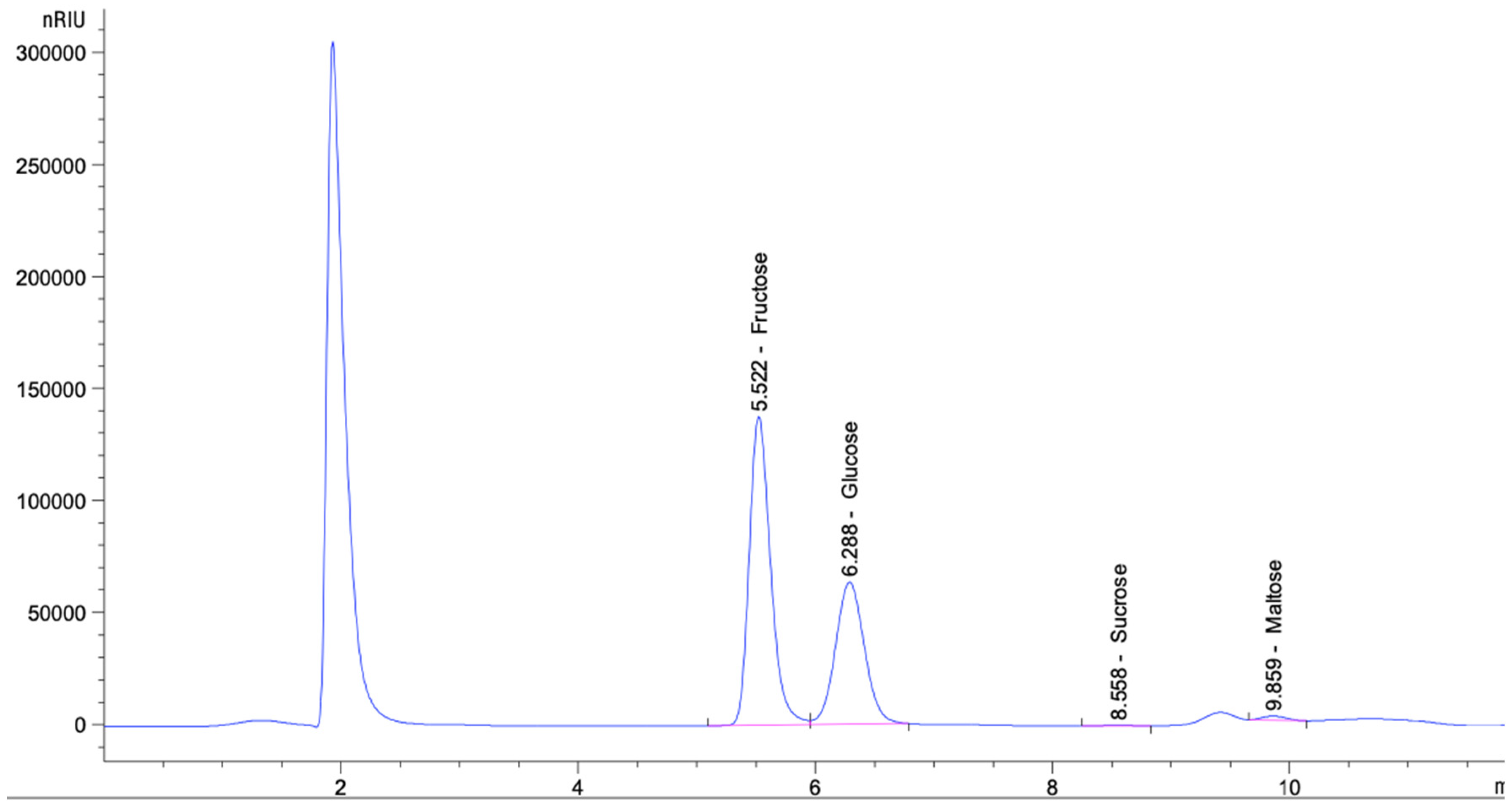
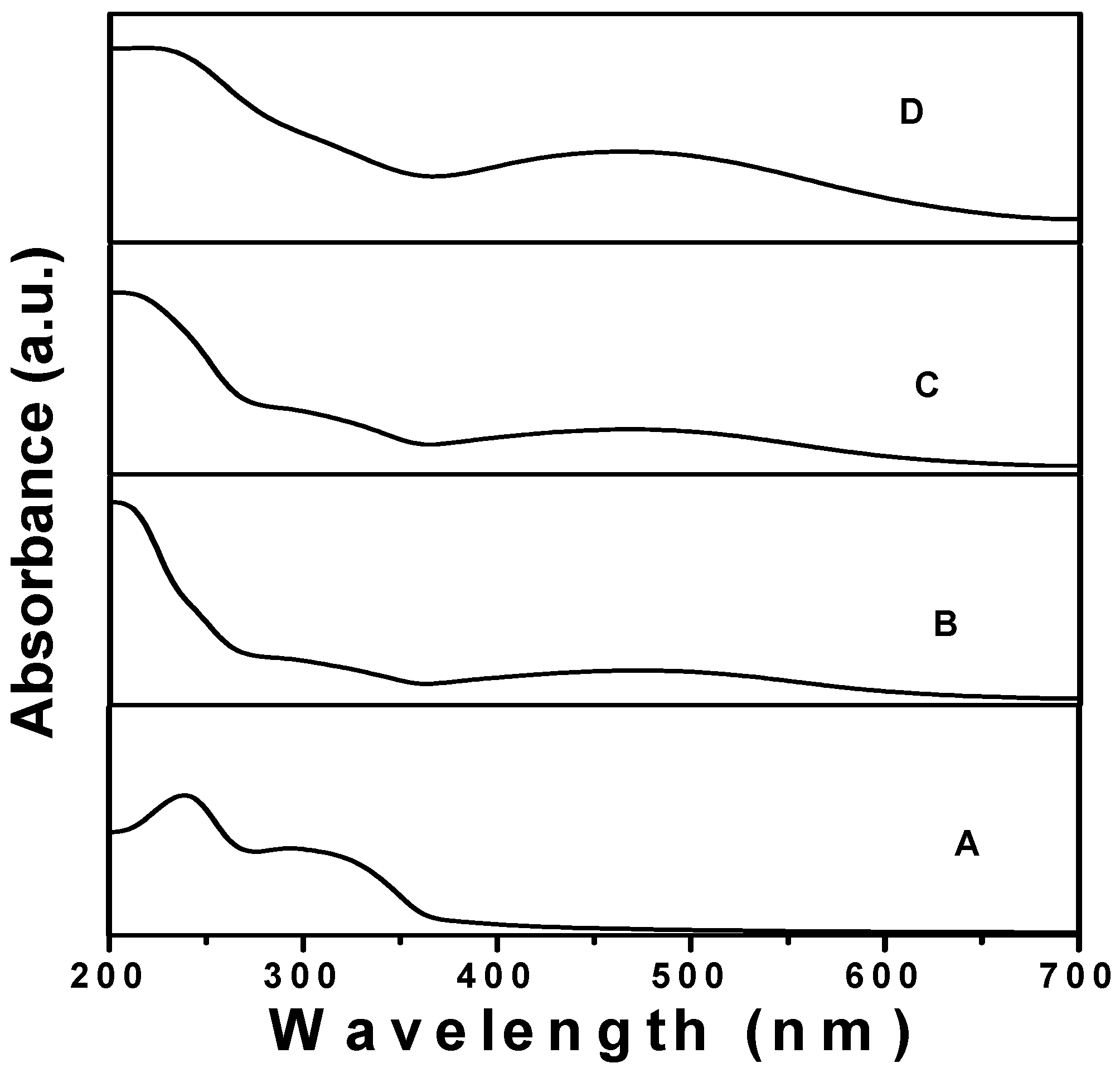
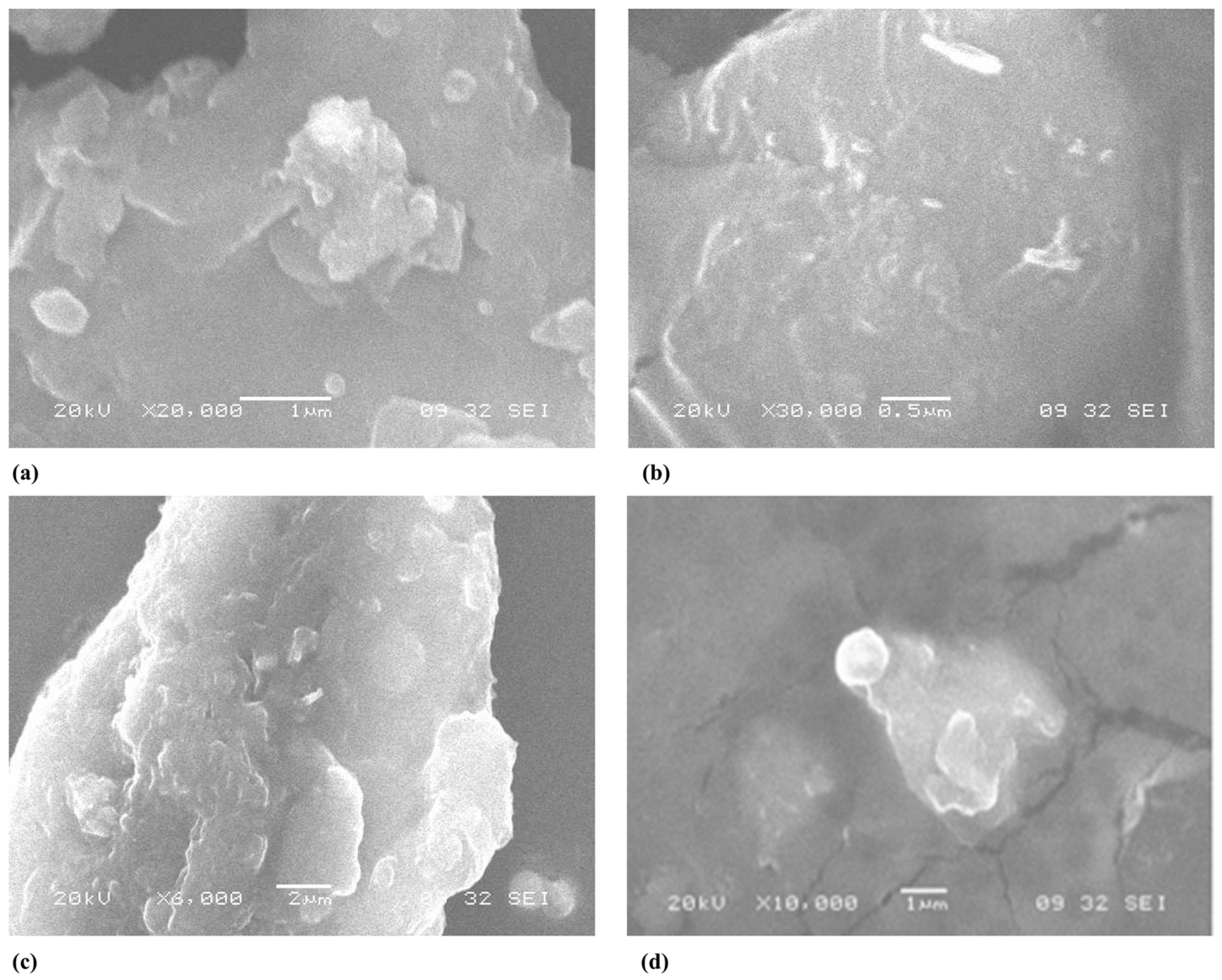

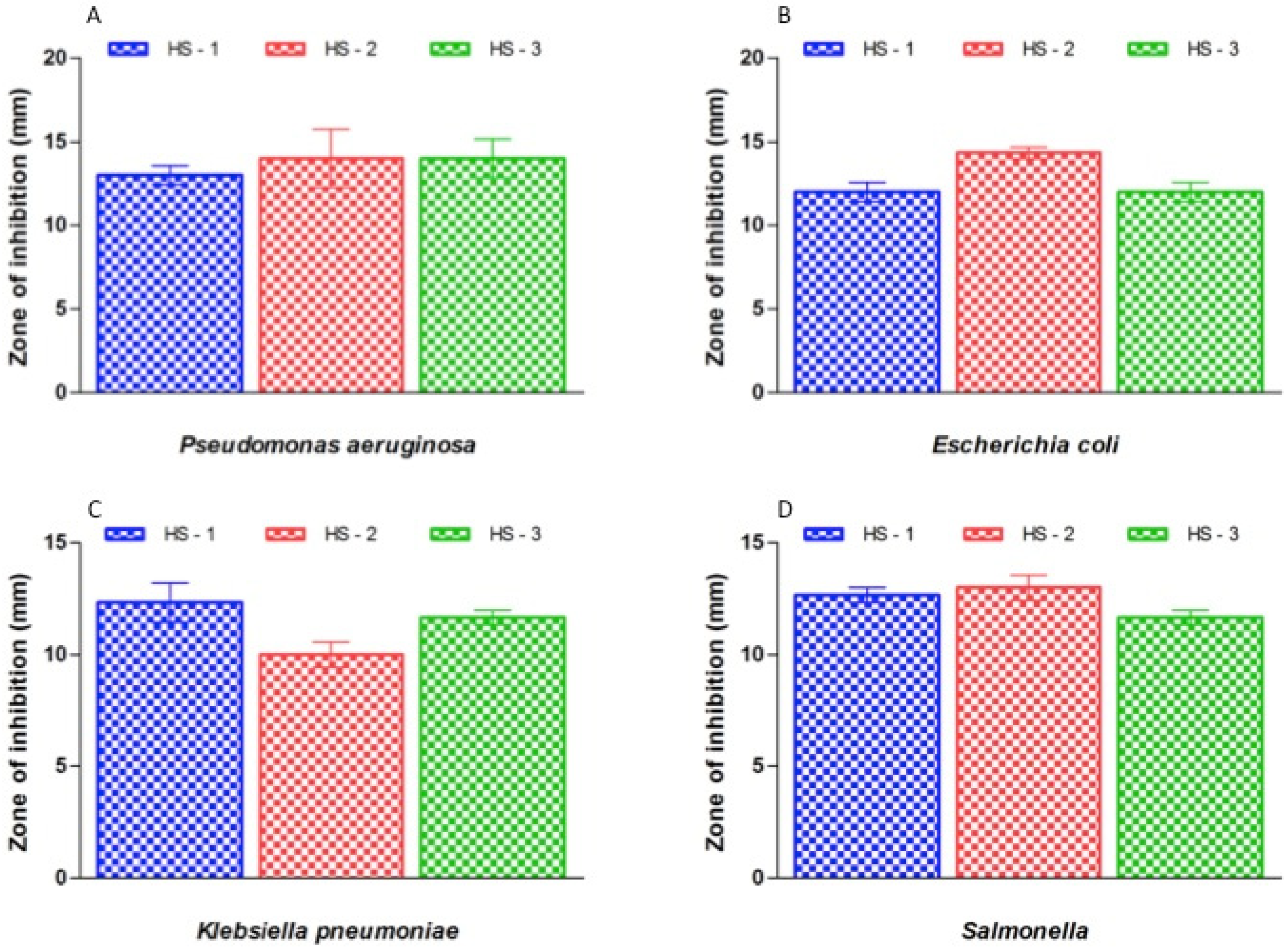
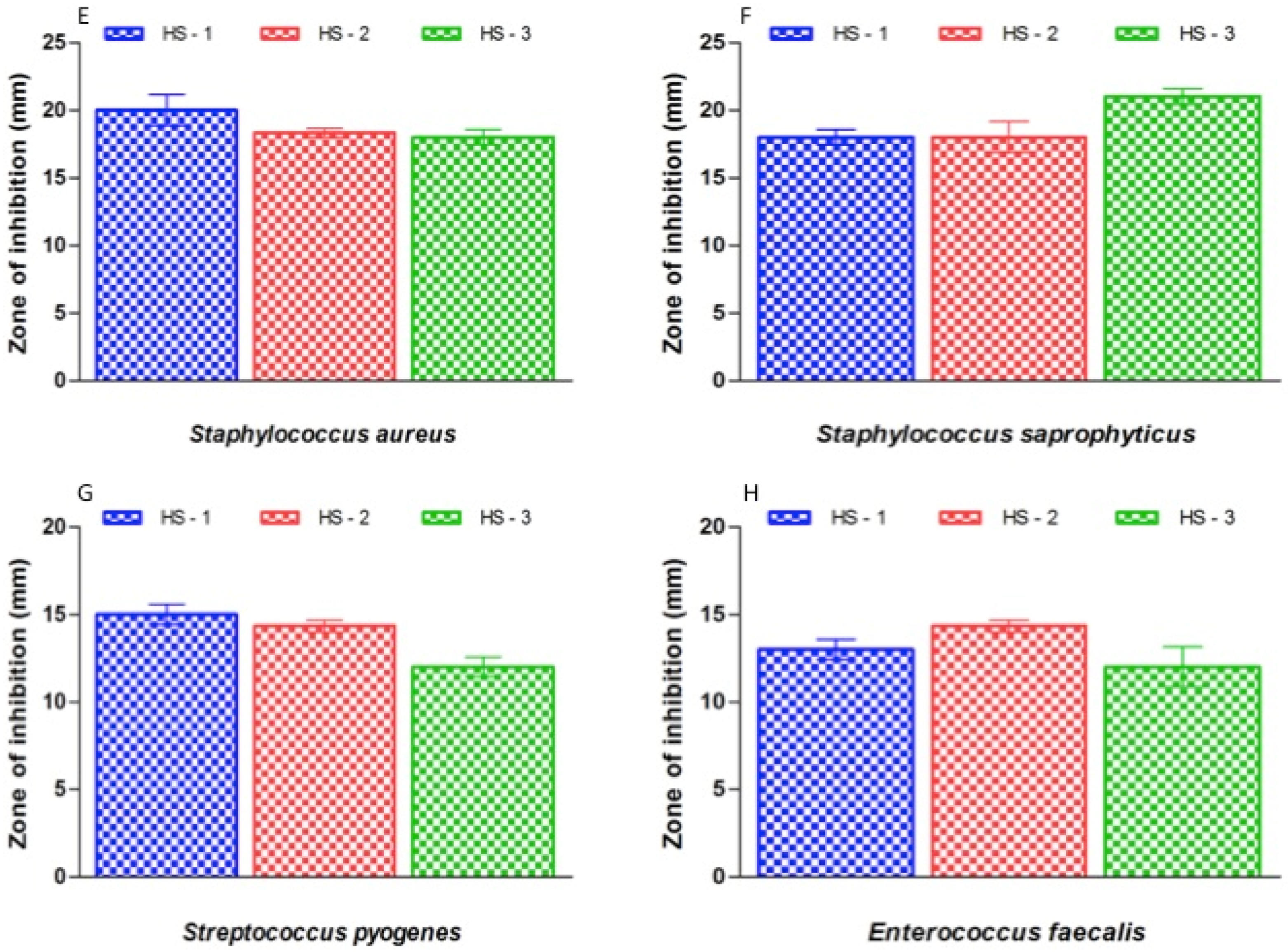
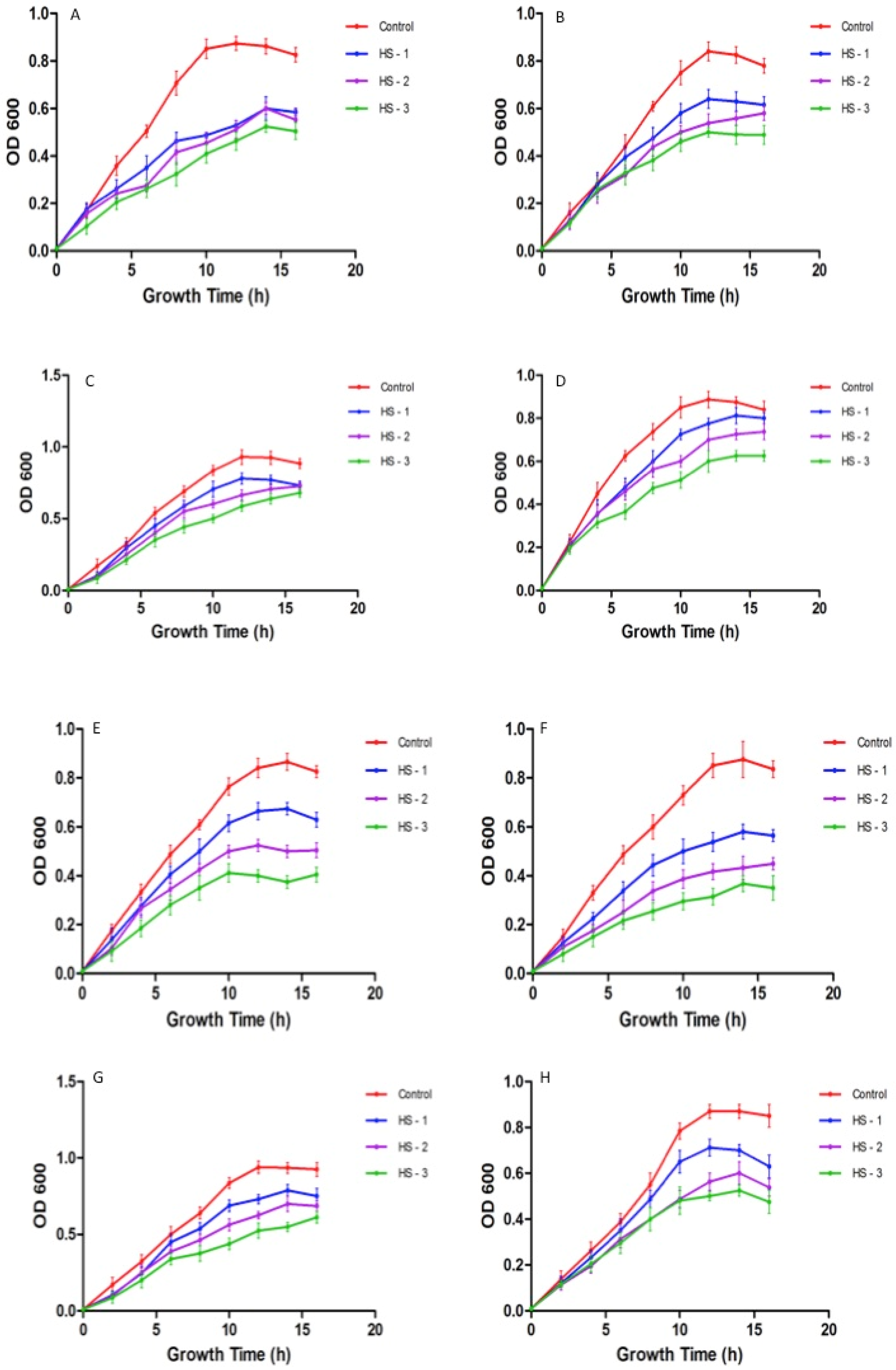
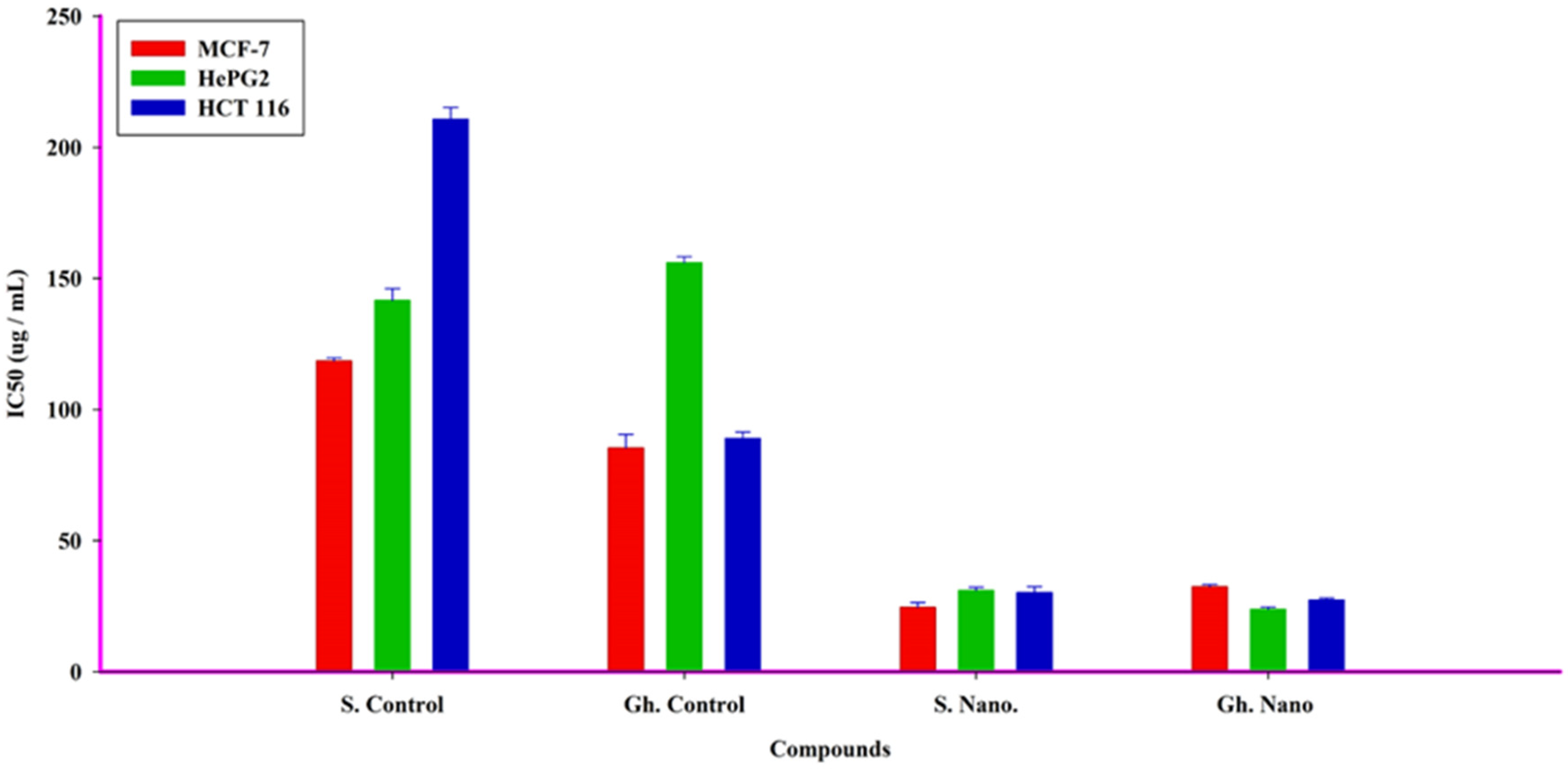
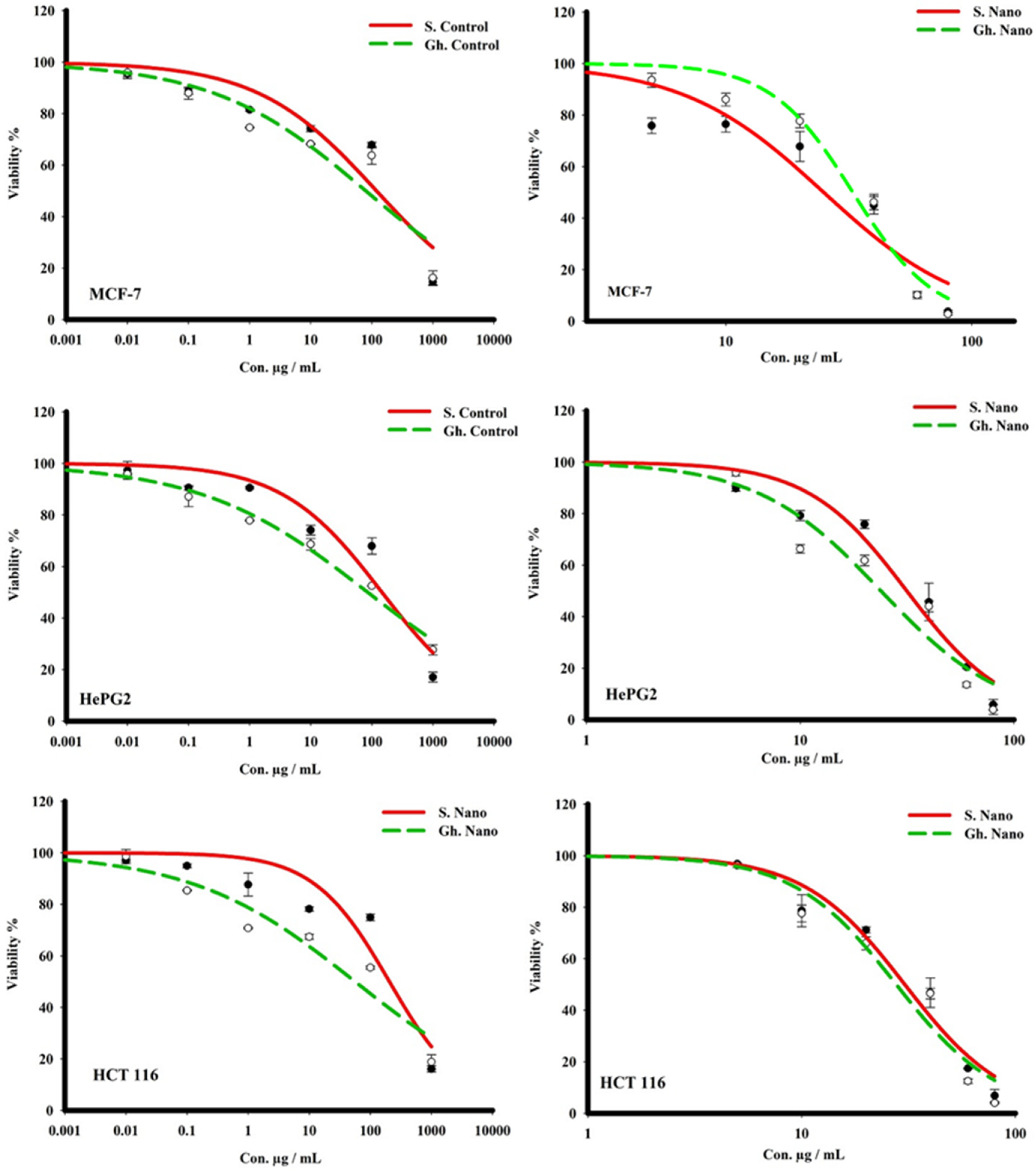
| Parameters | Minimum | Maximum | Mean | Std. Deviation |
|---|---|---|---|---|
| Fructose | 38.36 | 39.12 | 38.80 | 0.39 |
| Glucose | 23.91 | 24.78 | 24.31 | 0.44 |
| Sucrose | 0.05 | 0.10 | 0.076 | 0.03 |
| Maltose | 1.18 | 1.63 | 1.45 | 0.24 |
| pH | 3.80 | 3.82 | 3.80 | 0.01 |
| Moisture | 16.00 | 17.00 | 16.66 | 0.57 |
| Treatments | IC50 (µg/mL) | ||
|---|---|---|---|
| MCF-7 | HepG2 | HCT 116 | |
| S. Control | 118.6 ± 1.1 | 141.6 ± 4.5 | 210.9 ± 4.5 |
| Gh. Control | 85.5 ± 5.1 | 156.1 ± 2.3 | 89.02 ± 2.4 |
| S. Nano | 24.6 ± 1.8 | 31.08 ± 1.1 | 30.3 ± 0.2 |
| Gh. Nano | 32.5 ± 0.7 | 23.9 ± 0.8 | 27.4 ± 0.7 |
Disclaimer/Publisher’s Note: The statements, opinions and data contained in all publications are solely those of the individual author(s) and contributor(s) and not of MDPI and/or the editor(s). MDPI and/or the editor(s) disclaim responsibility for any injury to people or property resulting from any ideas, methods, instructions or products referred to in the content. |
© 2023 by the authors. Licensee MDPI, Basel, Switzerland. This article is an open access article distributed under the terms and conditions of the Creative Commons Attribution (CC BY) license (https://creativecommons.org/licenses/by/4.0/).
Share and Cite
Ghramh, H.A.; Alrumman, S.A.; Ahmad, I.; Kalam, A.; Elbehairi, S.E.I.; Alfaify, A.M.; Mohammed, M.E.A.; Al-Sehemi, A.G.; Alfaifi, M.; Al-Shehri, B.M.; et al. Chemical Characterization of Honey and Its Effect (Alone as well as with Synthesized Silver Nanoparticles) on Microbial Pathogens’ and Human Cancer Cell Lines’ Growth. Nutrients 2023, 15, 684. https://doi.org/10.3390/nu15030684
Ghramh HA, Alrumman SA, Ahmad I, Kalam A, Elbehairi SEI, Alfaify AM, Mohammed MEA, Al-Sehemi AG, Alfaifi M, Al-Shehri BM, et al. Chemical Characterization of Honey and Its Effect (Alone as well as with Synthesized Silver Nanoparticles) on Microbial Pathogens’ and Human Cancer Cell Lines’ Growth. Nutrients. 2023; 15(3):684. https://doi.org/10.3390/nu15030684
Chicago/Turabian StyleGhramh, Hamed A., Sulaiman A. Alrumman, Irfan Ahmad, Abul Kalam, Serag Eldin I. Elbehairi, Abdulkhaleg M. Alfaify, Mohammed Elimam Ahamed Mohammed, Abdullah G. Al-Sehemi, Mohammad Alfaifi, Badria M. Al-Shehri, and et al. 2023. "Chemical Characterization of Honey and Its Effect (Alone as well as with Synthesized Silver Nanoparticles) on Microbial Pathogens’ and Human Cancer Cell Lines’ Growth" Nutrients 15, no. 3: 684. https://doi.org/10.3390/nu15030684
APA StyleGhramh, H. A., Alrumman, S. A., Ahmad, I., Kalam, A., Elbehairi, S. E. I., Alfaify, A. M., Mohammed, M. E. A., Al-Sehemi, A. G., Alfaifi, M., Al-Shehri, B. M., Alshareef, R. M. H., ALaerjani, W. M. A., & Khan, K. A. (2023). Chemical Characterization of Honey and Its Effect (Alone as well as with Synthesized Silver Nanoparticles) on Microbial Pathogens’ and Human Cancer Cell Lines’ Growth. Nutrients, 15(3), 684. https://doi.org/10.3390/nu15030684








